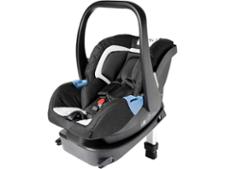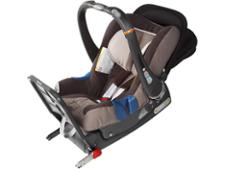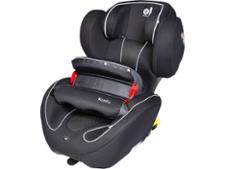The law on child car seats
Find out when you have to use a baby or child car seat, and the penalties that await if you don't and are caught.

UK law states that children must use a child car seat until they're 12 years old or 135cm/4ft 5in tall, whichever comes first.
However, safety experts recommend that you use a child car seat for all children under 150cm/4ft 11in. This height is the legal requirement in Ireland and also some European countries, such as Germany and France.
For children weighing more than 36kg (5st 10lb) but under 150cm/4ft 11in, our advice is to go by height.
Need a car seat? A Best Buy car seat provides good protection from both front-impact and side-impact crashes.
What is the correct child car seat?
An appropriate child car seat is one that:
- conforms to the United Nations standard, ECE Regulation 44/03 or ECE 44/04 (this is marked on a label on the seat), or
- approved under R129 (also known as i-Size.)
- is suitable for the child's weight and size, or height (if buying an i-Size seat)
- is correctly fitted according to the manufacturer's instructions.
Only an EU-approved car seat can be used in the UK.

Height-based or weight-based car seats?
You can choose a child car seat based on your child's weight or height.
Weight-based child car seats:
Most child car seats are split into groups according to the weight of the child they're designed to protect.
These groups are defined by United Nations safety regulations and cover children from birth all the way up to 12 years of age or 135cm which is around 36kg.
See our guide to car seat weight groups for more information on what seat to buy and when.
Height-based car seats:
i-Size is part of the European child car seat regulation R129, which came into force in the UK at the beginning of April 2015.
i-Size car seats go by height instead of weight. A true i-Size car seat will only use Isofix connectors, although some infant carriers can still be installed into your car via the car's adult seat belt.
i-Size car seats will fit all i-Size-certified cars and almost all cars with Isofix. Check with the manufacturer of your car.
See our guide to i-Size car seats for more information on this type of child car seat.
| Child car seat law by age | |||
|---|---|---|---|
| Age of child | Front seat | Rear seat | Who is responsible? |
| Child up to three years old | Correct child car seat must be used. |
Children under three must be in a child car seat. If there’s no room for a third child seat in the back of your vehicle. Children aged three or under can use the front seat but they must be in a child car seat. If your vehicle does not have seat belts in the rear, a child under three can’t travel. Children under three must be in a child car seat. You can’t take children under three on an unexpected journey in a vehicle without a seat belt or the correct child car seat. The only exception to this rule is if it's in a licensed taxi or minicab and the rear seats are separated from the driver by a fixed partition and the child travels on the rear seats. |
Driver |
| Child from third birthday up to 135cm in height, or 12th birthday, whichever they reach first | Correct child restraint must be used. |
Where seat belts are fitted, the correct child car seat must be used. If there’s no room for a third child seat in the back of your vehicle. Children aged three or older can sit in the back using an adult belt. If your vehicle does not have seat belts in the rear, a child aged three or older can travel in the back seat without a car seat and without a seat belt. If the correct child seat isn’t available, a child aged three or older can use an adult seat belt but only if the journey is unexpected and necessary and over a short distance. |
Driver |
| Child over 135cm in height or 12-13 years old | Seat belt must be worn. | Seat belt must be worn. | Driver |
| Passengers aged 14 years old and over | Seat belt must be worn. | Seat belt must be worn. | Passenger |
Child car seats in vans
The rules for vans are the same as for cars.
Children with disabilities or medical conditions
Gov.uk states that the same rules apply for children with disabilities or medical conditions, but they can use a disabled person’s seat belt or a child restraint designed for their needs.
A doctor can issue an exemption certificate if a child is unable to use a restraint or seat belt because of their condition.

Exceptions to the child car seat law
There are a limited number of exceptions to the law, as we've mentioned in the table above:
In taxis and minicabs (private hire vehicles)
If the licensed taxi or minicab has a fixed partition that separates the front and rear seats:
- children under three can travel without a child’s car seat or seat belt, but only on a rear seat
- children aged three or older can travel in a front or rear seat without a child’s car seat if they wear an adult seat belt
You must follow the normal rules for using a child car seat or booster seat if the vehicle doesn’t have a fixed partition.
No room for a third child seat in the back
If there’s no room for a third child seat in the back seat (where two occupied child car seats in the rear prevent the fitting of a third child safety seat) a third child under the age of three can’t travel unless they are in the front seat with the correct child seat.
Children over three years can either use the front seat with the correct child seat or sit in the back using an adult belt.
Unexpected but necessary journeys over a short distance
If you have an unexpected but neccessary journey over a short distance, and you do not have the correct child car seat, a child over three years old can use the adult seat belt.
Picking up a friend's child from school does not count as an unexpected but neccessary journey.
You must not take children under three in a vehicle without a seat belt
or the correct child car seat (except in the back seat of a taxi or
minicab).
Vehicles without seat belts
Children under three must be in a child car seat. If there’s no seat belt, they can’t travel. A child aged three or older can travel in a back seat without a car seat and without a seat belt if the vehicle doesn’t have one.

Penalties for ignoring the law on using child car seats
The consequences of ignoring the legal requirements could be expensive (at best) or fatal (at worst). Police are able to administer an on-the-spot fine of £30, or £500 if the case is referred to court.
Remember, it's the driver of the vehicle's responsibility to ensure all passengers are safely strapped in. If you're the driver, always check.
The consequences of ignoring the legal requirements could be expensive (at best) or fatal (at worst)


